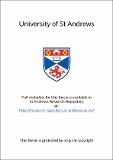Files in this item
Biochemical and genetic analysis of the nitrate assimilatory yeast Hansenula wingei
Item metadata
| dc.contributor.advisor | Kinghorn, James R. | en |
| dc.contributor.author | Jones, Christopher Peter | en |
| dc.coverage.spatial | 336p | en |
| dc.date.accessioned | 2021-04-08T08:59:47Z | |
| dc.date.available | 2021-04-08T08:59:47Z | |
| dc.date.issued | 1987 | |
| dc.identifier.uri | https://hdl.handle.net/10023/21983 | |
| dc.description.abstract | The heterothallic, haploid, nitrate assimilatory yeast Hansenula Wingei was investigated with respect to three aspects of nitrate assimilation. 1) One natural isolate, ATCC 28162 was chosen -for investigation. An efficient extraction procedure was developed. Attempts to assay xanthine dehydrogenase were unsuccessful. Nitrate reductase was not inhibited in vitro by either 1mM or 100mM ammonium, glutamate, or glutamine. However nitrite reductase was inhibited in vitro by 100mM glutamate or 100mM glutamine. A low constitutive level of nitrate and nitrite reductase activity was detectable in repressed cultures. Only nitrate alone was able to induce the enzymes. In derepressed cultures nitrate and nitrite reductase activity diminished if ammonium, glutamate, or glutamine was added, even in the presence of nitrate. Cycloheximide prevented diminution of activity. 2) 300mM chlorate plus glutamate was used to select spontaneous mutants. The mutation frequency for chlorate resistance was estimated as 20%. The following classes were found: Class 1: nitrate non-utilising, nitrite utilising; Class 2: nitrate and nitrite non-utilising; Class 3: nitrate utilising, nitrite non-utilising; Class 4: nitrate and nitrite utilising. All mutants utilised hypoxanthine and other nitrogen sources. In Class 1 (nnu) a complicated pattern of 15 complementation groups was found. In Class 2 (nan) 3 inter—allelic complementation groups were found. Nitrate reductase was absent in all nnu mutants. nan mutants lacked virtually all activities. Class 1 mutants complemented Class 2. A model involving autogenous regulation was discussed to explain the complicated enzyme activities of nnu mutants. The possibility was discussed of nan mutants representing a positive regulatory locus concerned with the induction of nitrate reductase, nitrate reductase, and molybdenum cofactor biosynthesis. Attempts at performing tetrad analysis were unsuccessful. 3) A transformation protocol was optimised for H. Wingei. Attempts were made to transform leucine auxotrophs to prorotrophy, and wild type strains to hygromycin B resistance. No replicating plasmid was detected. It was assumed that transformation had resulted in the integration of the plasmid. Auxtotrophic mutants were found to be generally epistatic to nitrate assimilation mutants. | en |
| dc.language.iso | en | en |
| dc.publisher | University of St Andrews | en |
| dc.subject.lcc | QR151.Y3J7 | |
| dc.subject.lcsh | Yeast | en |
| dc.subject.lcsh | Plants--Assimilation | en |
| dc.title | Biochemical and genetic analysis of the nitrate assimilatory yeast Hansenula wingei | en |
| dc.type | Thesis | en |
| dc.type.qualificationlevel | Doctoral | en |
| dc.type.qualificationname | MSc Master of Science | en |
| dc.publisher.institution | The University of St Andrews | en |
This item appears in the following Collection(s)
Items in the St Andrews Research Repository are protected by copyright, with all rights reserved, unless otherwise indicated.

